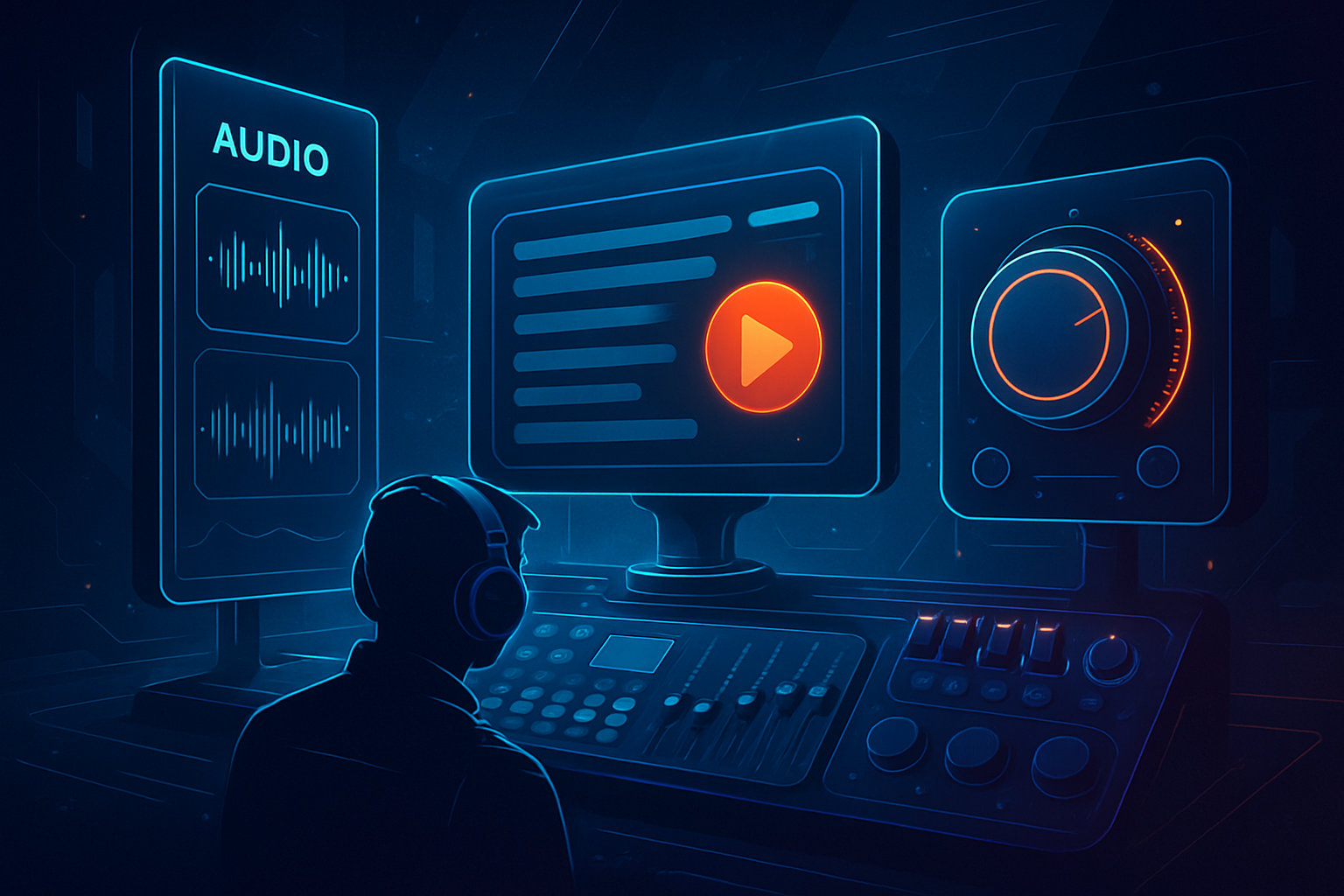【Unity笔记】Unity音效管理:ScriptableObject配置 + 音量控制 + 编辑器预览播放自动化实现
摘要:
本文介绍了如何在 Unity 中构建一个高效的音效管理系统,通过 ScriptableObject 实现音效集中配置,支持为每个音效单独设置音量,并通过自定义 Editor 实现音效的可视化预览播放与下拉选择播放功能,整个系统无场景污染、操作便捷,适用于中大型项目的音效统一管理与开发流程提效。

在 Unity 项目开发中,良好的音效管理系统可以大幅提升开发效率与维护性。尤其是在多人协作、音效较多、需要统一管理的场景下,通过 ScriptableObject 管理音效配置,并结合 Editor 工具自动生成与预览播放功能,是一种高效、专业的解决方案。
本文将从以下几个方面,从0开始构建一个完善的音效管理系统:
一、音效管理系统功能概览
主要包括以下核心功能:
- ✅ 自动扫描音效文件并生成配置数据(ScriptableObject);
- ✅ 每个音效支持单独设置播放音量;
- ✅ 在 Inspector 面板中可预览播放音效;
- ✅ 无污染场景(不生成临时 GameObject);
- ✅ 支持通过下拉选择播放指定音效。
二、配置类:使用 ScriptableObject 存储音效列表
定义一个名为 SoundEffectsConfig 的 ScriptableObject 用于存储音效数据,结构如下:
using UnityEngine;
using System.Collections.Generic;[CreateAssetMenu(fileName = "E_SoundEffectsConfig", menuName = "XRCore/音效配置")]
public class SoundEffectsConfig : ScriptableObject
{[System.Serializable]public class SoundEntry{public string name;public AudioClip clip;[Range(0f, 1f)]public float volume = 1.0f; // 每个音效的独立音量}public List<SoundEntry> soundList = new List<SoundEntry>();
}
使用
[CreateAssetMenu]后,可在 Unity Project 面板中右键快速创建。
三、自动生成音效配置的 Editor 工具
在 Assets/Editor/ 下新建一个 SoundEffectsManagerEditor.cs 脚本:
using UnityEditor;
using UnityEngine;
using System.IO;
using System.Linq;public class SoundEffectsManagerEditor : EditorWindow
{private static readonly string defaultAudioPath = "Assets/Resources/Audio/";private static readonly string configAssetPath = "Assets/Resources/E_SoundEffectsConfig.asset";[MenuItem("Tools/SoundManager/Generate configuration")]public static void GenerateSoundConfig(){// 创建目录if (!Directory.Exists("Assets/Resources")){Directory.CreateDirectory("Assets/Resources");AssetDatabase.Refresh();Debug.Log("已创建目录:Assets/Resources/");}if (!Directory.Exists(defaultAudioPath)){Directory.CreateDirectory(defaultAudioPath);AssetDatabase.Refresh();Debug.Log("已创建目录:" + defaultAudioPath);}// 查找所有音效string[] audioGuids = AssetDatabase.FindAssets("t:AudioClip", new[] { defaultAudioPath });var clips = audioGuids.Select(guid => AssetDatabase.LoadAssetAtPath<AudioClip>(AssetDatabase.GUIDToAssetPath(guid))).Where(clip => clip != null).ToList();if (clips.Count == 0){Debug.LogWarning("⚠️ 未在目录中找到任何 AudioClip!");return;}// 加载或创建配置var config = AssetDatabase.LoadAssetAtPath<SoundEffectsConfig>(configAssetPath);if (config == null){config = ScriptableObject.CreateInstance<SoundEffectsConfig>();AssetDatabase.CreateAsset(config, configAssetPath);AssetDatabase.SaveAssets();Debug.Log("已创建新的 SoundConfig.asset");}Undo.RecordObject(config, "更新音效配置");config.soundList.Clear();foreach (var clip in clips){config.soundList.Add(new SoundEffectsConfig.SoundEntry{name = clip.name,clip = clip,volume = 1.0f // 默认音量});}EditorUtility.SetDirty(config);AssetDatabase.SaveAssets();// ✅ 高亮展示配置文件Selection.activeObject = config;EditorGUIUtility.PingObject(config);Debug.Log($"音效配置更新完成,共 {clips.Count} 个音效已保存到 ScriptableObject。");}
}
四、在 Inspector 中预览音效播放(无污染方式)
使用 AudioSource.PlayClipAtPoint 会在场景中创建临时对象,容易污染编辑环境。我们推荐用如下方式播放预览音效:
private AudioSource previewSource;private void PlayPreview(AudioClip clip)
{if (clip == null) return;if (previewSource == null){GameObject go = EditorUtility.CreateGameObjectWithHideFlags("AudioPreviewer", HideFlags.HideAndDontSave, typeof(AudioSource));previewSource = go.GetComponent<AudioSource>();}previewSource.clip = clip;previewSource.loop = false;previewSource.Play();
}
HideFlags.HideAndDontSave确保该对象在场景中不保存、不显示、不影响运行。
五、运行时播放音效:支持按名称查找 + 音量控制
使用如下方法在代码中播放:
public class SoundPlayer : MonoBehaviour
{public SoundEffectsConfig config;public string soundName;public void PlaySound(){var entry = config.soundList.FirstOrDefault(e => e.name == soundName);if (entry != null && entry.clip != null){AudioSource.PlayClipAtPoint(entry.clip, transform.position, entry.volume);}else{Debug.LogWarning("音效未找到或为空!");}}
}
六、支持下拉列表选择音效(编辑器拓展)
实现一个自定义 Editor,为 SoundPlayer 脚本提供下拉选择功能,还可以一键预览播放。如下:
[CustomEditor(typeof(SoundPlayer))]
public class SoundPlayerEditor : Editor
{public override void OnInspectorGUI(){var player = (SoundPlayer)target;if (player.config == null){EditorGUILayout.HelpBox("请先拖入音效配置文件", MessageType.Warning);return;}var names = player.config.soundList.Select(s => s.name).ToList();int index = Mathf.Max(0, names.IndexOf(player.soundName));index = EditorGUILayout.Popup("选择音效", index, names.ToArray());player.soundName = names[index];if (GUILayout.Button("▶ 预览播放")){var entry = player.config.soundList.FirstOrDefault(e => e.name == player.soundName);if (entry?.clip != null){PlayPreview(entry.clip);}}DrawDefaultInspector();}private AudioSource previewSource;private void PlayPreview(AudioClip clip){if (previewSource == null){GameObject go = EditorUtility.CreateGameObjectWithHideFlags("AudioPreviewer", HideFlags.HideAndDontSave, typeof(AudioSource));previewSource = go.GetComponent<AudioSource>();}previewSource.clip = clip;previewSource.Play();}
}
总结
通过以上实现,我们构建了一个 高效、可扩展、可视化的音效管理工具链,极大提升了 Unity 项目中音效的管理体验:
| 功能 | 是否支持 |
|---|---|
| 自动扫描音效并生成配置 | ✅ |
| ScriptableObject 存储数据 | ✅ |
| 每个音效支持独立音量控制 | ✅ |
| Inspector 中预览播放音效 | ✅ |
| 下拉选择指定音效播放 | ✅ |
如果你觉得这篇文章对你有帮助,欢迎点赞收藏、关注专栏!
